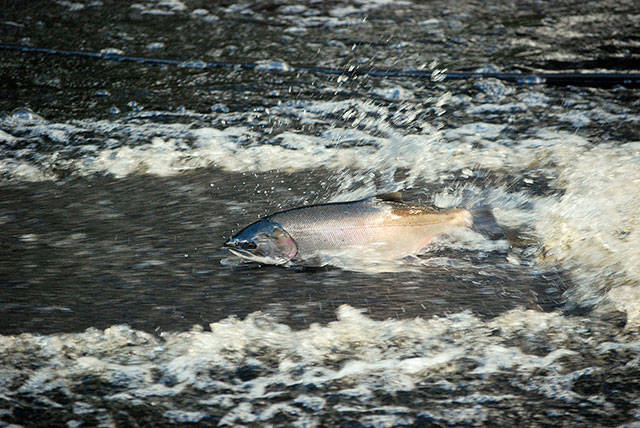Salmon exposed to toxic stormwater runoff can die in a matter of hours, and scientists are asking for Puget Sound area residents to help identify affected streams, including Mill Creek in Kent, to study the phenomenon.
Scientists from the National Oceanic and Atmospheric Administration, U.S. Fish and Wildlife and Washington State University – collectively called the Puget Sound Stormwater Science Team – have been studying the effects of stormwater runoff on Pacific salmon species for almost two decades. Working to narrow down the toxic chemicals that are likely responsible, the team is unveiling a new interactive website that lets citizen volunteers help map salmon deaths.
As urban growth and development continues in the Puget Sound region, scientists anticipate that the coho mortality syndrome will expand, and will have significant impacts on wild coho populations, according to a Tuesday U.S. Fish and Wildlife news release. This is where area residents come in to helpscientists identify the extent of the phenomenon, and continue to refine scientists’ understanding at the toxic chemicals at play in affected areas.
“Media coverage of our work last year inspired some members of the public to report observations of coho suffering from the syndrome,” said Jay Davis, environmental toxicologist with U.S. Fish and Wildlife. “We realized that residents of the Puget Sound region can provide important data to help us document affected watersheds. There are potentially thousands of toxic chemicals in stormwater runoff, and refining our understanding of where and when this phenomenon is occurring can help us narrow our focus and provide an important part to this puzzle.”
The website includes interactive tools that allow users to view the Puget Sound basin and affected watersheds (including Mill Creek in Kent), and train them to identify coho salmon and report suspected coho mortality as citizen scientists. Although studies with other species are ongoing, initial evidence suggests that coho are particularly vulnerable to the syndrome.
Clearer picture of mortality
Coho returning to Puget Sound every autumn are an important food source for many animals, including endangered Southern Resident Killer Whales.
In a recently released draft report, the Southern Resident Killer Whale Task Force created by Gov. Jay Inslee recognized the importance of stormwater as a source of pollution in Puget Sound, as well as the need to better understand the impacts of toxics on orcas and their salmon prey.
WSU researchers, led by Jen McIntyre, assistant professor at the WSU-run Washington Stormwater Center in Puyallup, have found that coho get sick and die within just a few hours of exposure to polluted stormwater.
“Urban runoff contains a soup of heavy metals and hydrocarbons that are highly toxic to fish,” McIntyre said. “Every coho that dies in our polluted urban watersheds before it gets a chance to spawn means less eggs, fewer fry, and fewer returning fish to feed hungry orcas.”
“With this new, interactive story map, citizens along the Puget Sound can help scientists confirm their latest predictions of where coho are in the most trouble,” said Nat Scholz, an ecotoxicologist with NOAA’s Northwest Fisheries Science Center in Seattle. “This will help us understand where green stormwater infrastructure and similar strategies to promote clean water and healthy habitats are most needed.”
While the new story map is aimed at coho, efforts to reduce toxic runoff to Puget Sound lakes, rivers, and marine waters will benefit other species as well.
Coho salmon are an important part of the culture, history, and economy of the Pacific Northwest. This iconic species is widely distributed in lowland watersheds that are vulnerable to ongoing and future development. The role of water pollution in the continued decline of coho populations remains poorly understood.
To learn more about how you can help, including identifying and reporting coho mortality, visit arcg.is/0SivbL.
Talk to us
Please share your story tips by emailing editor@kentreporter.com.
To share your opinion for publication, submit a letter through our website https://www.kentreporter.com/submit-letter/. Include your name, address and daytime phone number. (We’ll only publish your name and hometown.) Please keep letters to 300 words or less.

